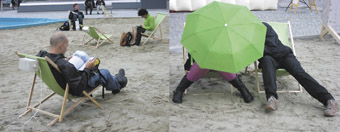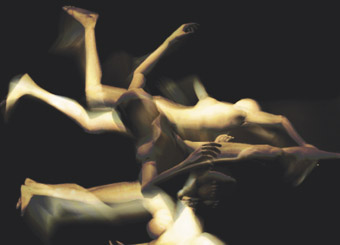empathy and otherness
somaya langley on immersive art at ars electronica

Pfarrplatz Lido (Second Life/Bondi Beach) – Ars Electronica Futurela
photo Somaya Langley
Pfarrplatz Lido (Second Life/Bondi Beach) – Ars Electronica Futurela
AN AUSTRALIAN MEDIA ARTIST ONCE TOLD ME TO BE CAUTIOUS WHEN NAMING AN ARTWORK AS THE VERY TITLE HAS THE POTENTIAL TO BRING FORTH ITS ESSENCE INTO EXISTENCE. I WAS REMINDED OF THIS CONVERSATION WHEN ARRIVING IN LINZ IN THE MIDST OF A HEAVY AFTERNOON DOWNPOUR WITH THE KNOWLEDGE THAT ONE OF THE SCHEDULED WORKS IN THIS YEAR’S ARS ELECTRONICA WAS AN EXCERPT FROM PETER WILLIAM HOLDEN’S AUTOGENE—UMBRELLAS SYNCHRONISED TO THE SOUNDS OF “SINGIN’ IN THE RAIN.” WHILE SINGING MIGHT NOT HAVE BEEN THE ACTIVITY OF CHOICE, ONE THAT QUICKLY CAPTURED ATTENTION OF MANY WAS THE OPPORTUNITY TO COMBAT THE COLD TEMPERATURES.
pfarrplatz lido
The drinking of hot punch at an artificial beach constructed by the Ars Electronica Futurelab in the likeness of Sydney’s Bondi Beach was a profoundly semi-virtual world experience. Over the first cup, we tried to comprehend the relationship between this patch of sand in Pfarrplatz and its apparent association with Second Life. While a comment about “Second Life invading my first” was bandied around, it was only during consecutive visits to this gathering place that the connections became obvious.
Protected, and therefore obscured, by white plastic tubs were laptops where individuals could log into Second Life, situated in the virtual equivalent of the Pfarrplatz beach, and ‘talk’ (in conventional SL style) with real-world participants. The twist was that that real-world participants were delivered the messages via computerised voices—some with particular idiosyncrasies, such as children screaming. Unfortunately, communication was unidirectional and real-world inhabitants had no way of replying apart from looking bewildered, annoyed or amused. Situated alongside the beach was a blow-up performance venue resembling a children’s jumping castle where a range of audiovisual acts performed, including Australia’s Botborg. Despite the weather, this location became a regular haunt for festival attendees. Who ever said that water, sand and technology don’t mix?

EED, Kurt Hentschläger
courtesy of the artist
EED, Kurt Hentschläger
feed
Kurt Hentschläger, an Austrian and long-time resident of the USA, re-staged FEED, originally commissioned for the 2005 Venice Biennale. The performance took place in an old underground bunker and, prior to admission, the sense of anticipation built as audience members were required to declare the state of their health. Anyone suffering from headaches, anxiety attacks, “anyone under the influence of medication for the treatment of depression” through to epilepsy, was to be excluded from attending if they did not sign a disclaimer.
FEED takes place in two parts, the first being an audiovisual experience in traditional surround-sound cinema mode. Animated clones float in space and at intervals jerk and twitch simultaneously. Without warning, smoke machines billow out clouds and in minutes the audience is engulfed in fog. I can’t see my hand inches from my nose and realise that now there is no way to back out. Sharp flickering patterns of interference and revolving coloured light emerge, evocative of a hallucinogenic experience and coupled with sound that vibrates not only your eardrums but your whole body. Hentschläger uses stroboscopic lighting accompanied by resonant drones so that his work “happens as much in your brain as in your eyes, and in the rest of your body”, adding that something initially scary can ultimately become peaceful and sublimely beautiful.
audiowalk gusen
Christoph Mayer chm’s AudioWalk Gusen, subtitled The Invisible Camp and created over a three-year period by a dozen-strong project team, far surpassed any expectations with its simplicity and elegance of construction. Technology was definitely not the focus, used only as the delivery tool, presenting previously unspoken and unheard accounts of numerous atrocities. Discussions with the creator on the way to the audio walk’s starting point gave no hint of what was to follow, or the very personal nature of the work. AudioWalk Gusen takes place on the former location of the Nazi concentration camps Gusen I and II.
A single iPod and set of headphones accompany you on the solo journey around the small town, allowing the past to emerge and become corporeal. Layers of present-day suburban tranquility are slowly peeled away to reveal a terrifying past. The juxtaposition of past and present climaxed for me when, listening to accounts of the mass graves located on a particular site, I saw a group of children with coloured chalk drawing an aerial view of a shopping centre in the middle of the asphalt road.
While the walk should have been straightforward, at one point tears obscured my ability to follow directions and, inevitably, I became lost. Existing in both the past and present became exceedingly difficult, given that I was rendered almost useless due to the intense nature of the work’s content. Careful construction of a woman’s narrative, a soundscape of noises of life inside and out of the camp grounds, and a sparse, minimal soundtrack were interwoven with testimonies from concentration camp survivors, past and current village members and former SS officers. Memories are forever imprinted upon these voices. One story impossible to forget is of a camp survivor’s childhood memory of witnessing other children, bound in sacks, thrown repeatedly against an apartment building wall until they were dead.
Two hours later I arrived at the endpoint as daylight was fading. AudioWalk Gusen continues to resonate with me—for weeks it entered my thoughts within minutes of waking up each morning. The work, available in an English translation, exists as an ongoing installation with the audio equipment available for hire from local restaurants nearby the Gusen Memorial.
post-immersion
Gusen Audiowalk and FEED each encourage my belief that embodied and immersive artworks are an incredibly powerful and very direct means of delivering concepts, of conveying the ‘other’s’ experience and developing empathy. Post-immersion, these artworks at Ars Electronica have significantly impacted on my daily life. This is how history should be learnt.
Festival Ars Electronica 2007, Goodbye Privacy, Linz, Austria, Sept 5-11,
www.aec.at/en/festival2007
RealTime issue #82 Dec-Jan 2007 pg. 16






